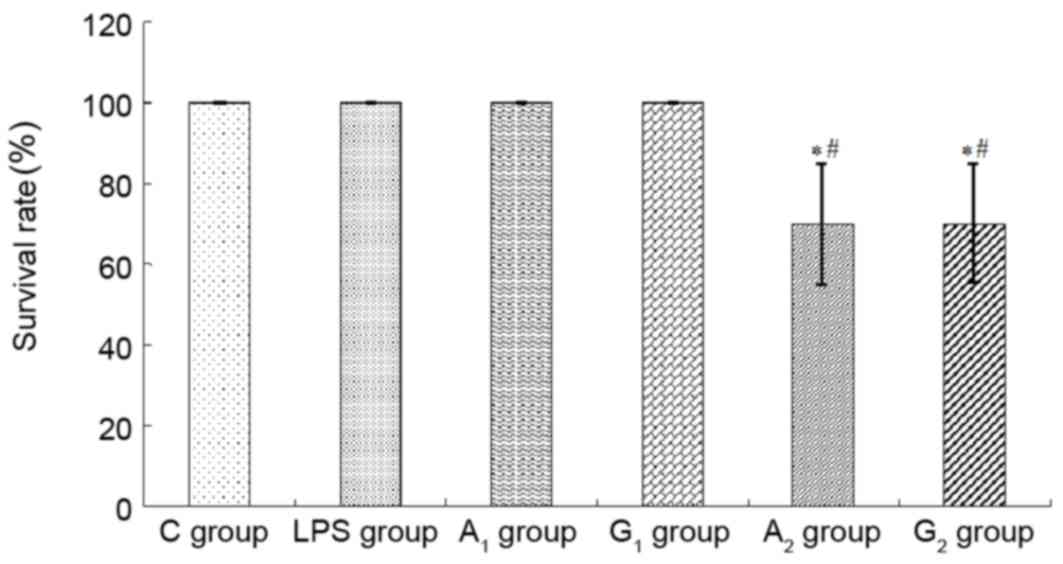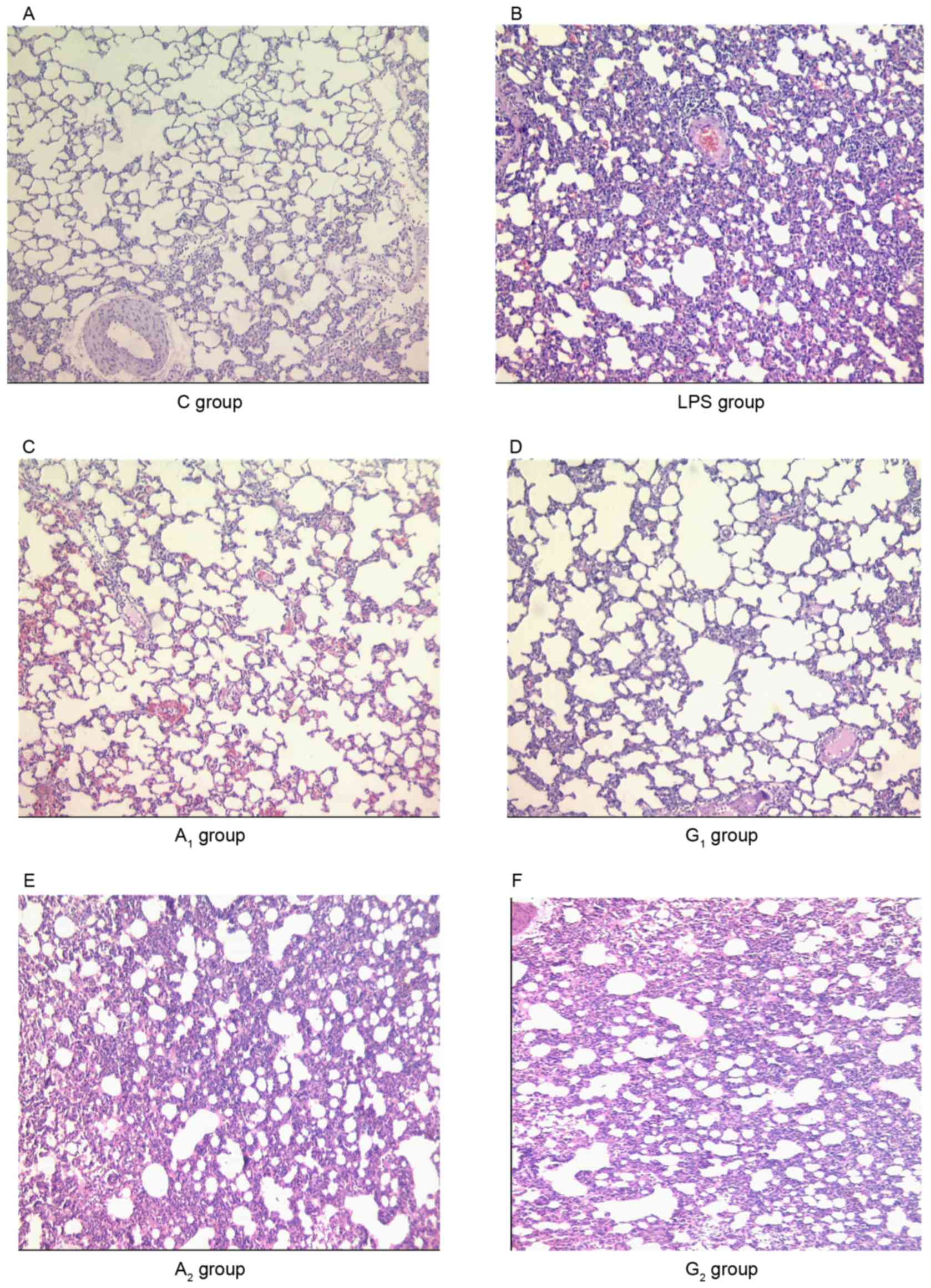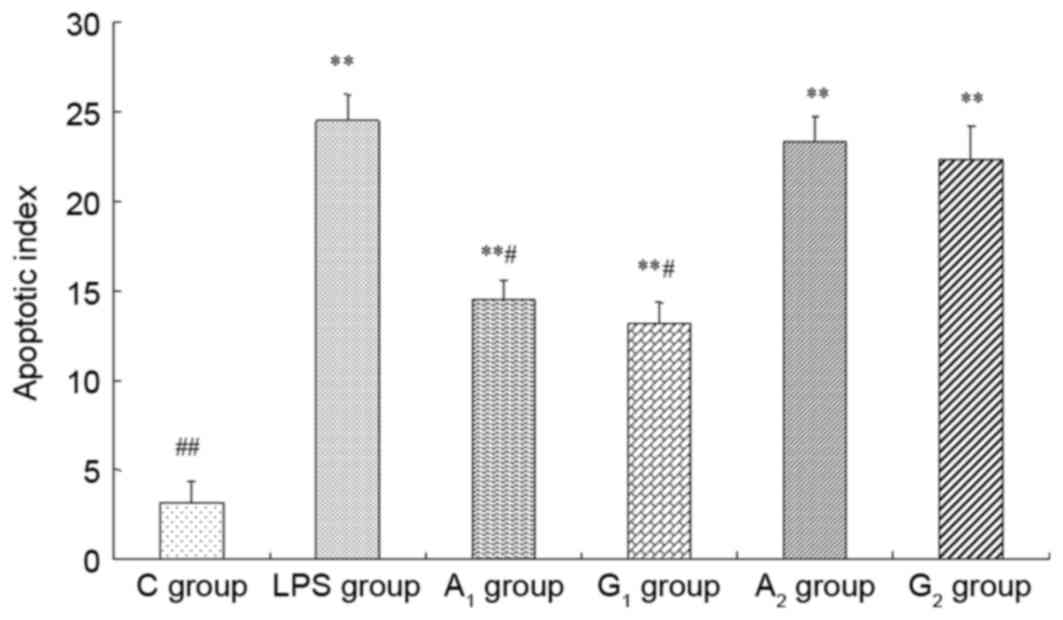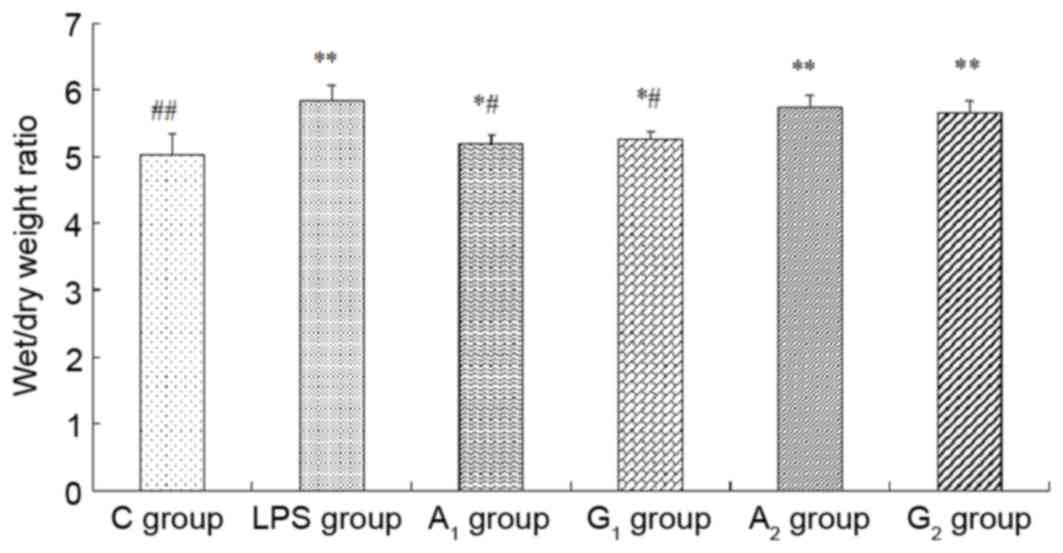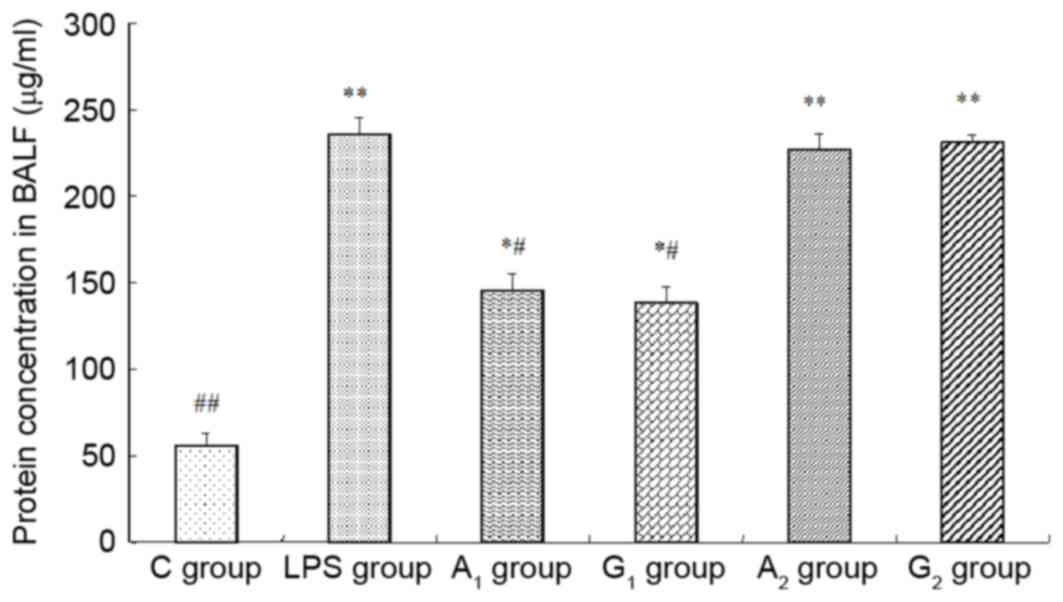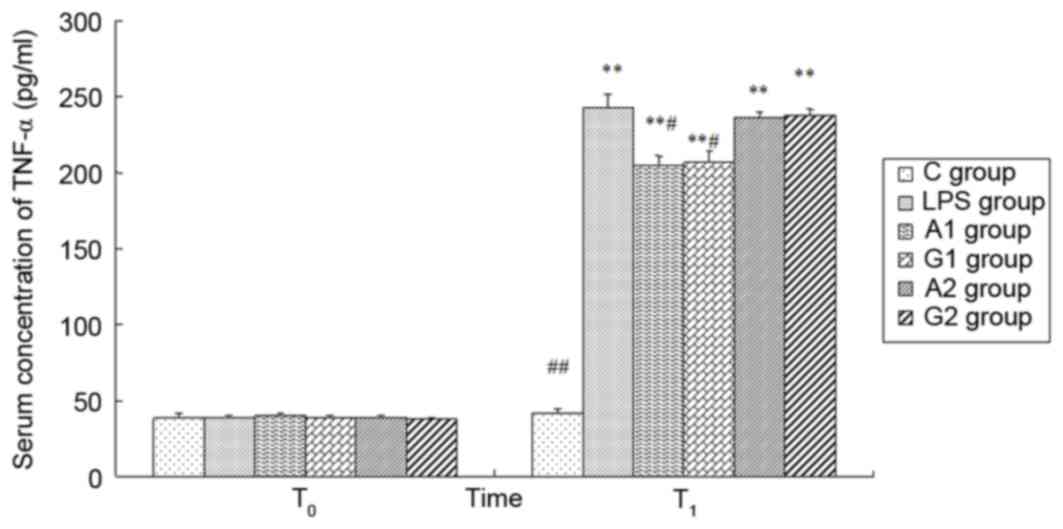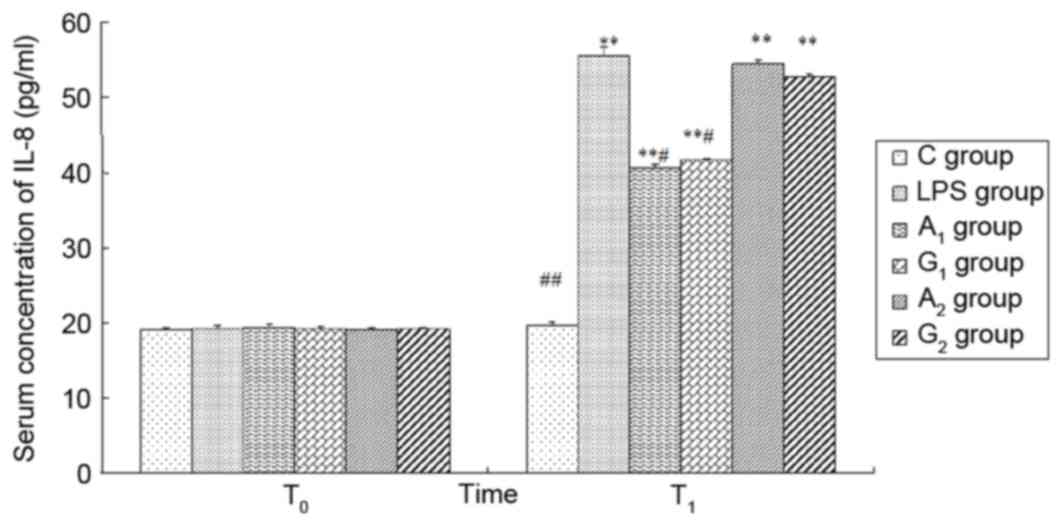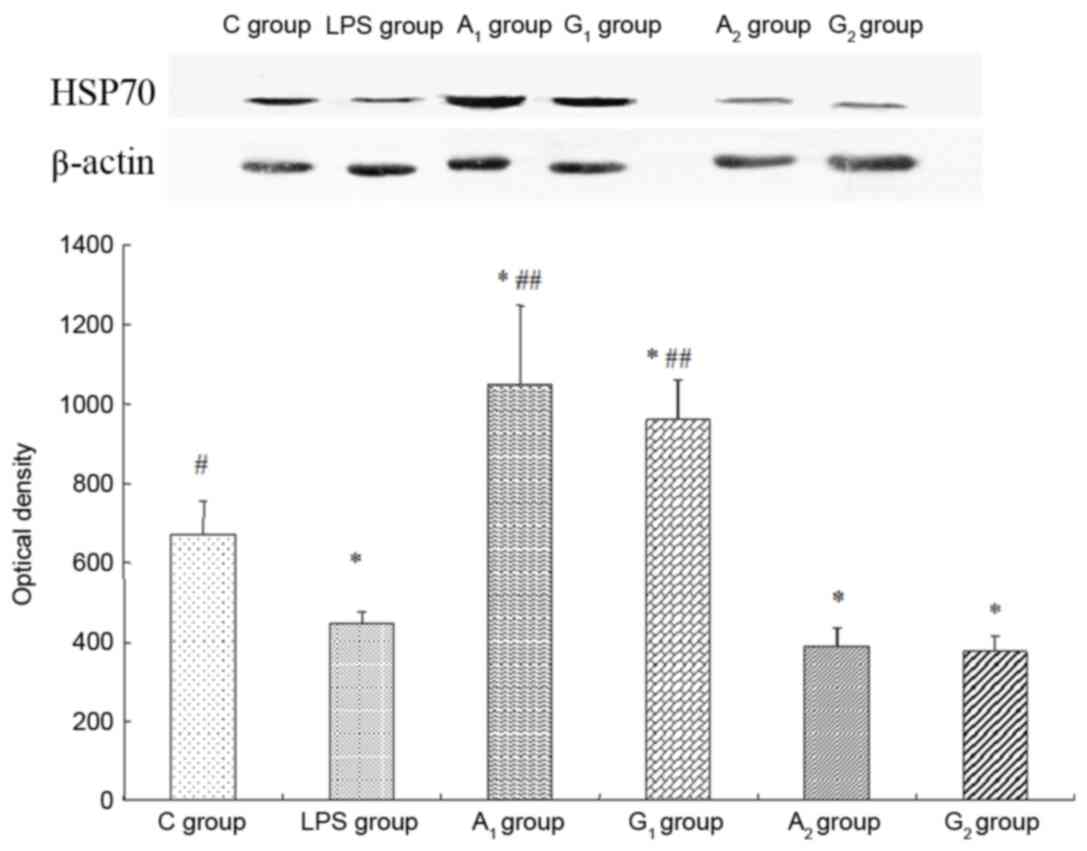Alanyl‑glutamine prophylactically protects against lipopolysaccharide‑induced acute lung injury by enhancing the expression of HSP70
- Authors:
- Published online on: June 30, 2017 https://doi.org/10.3892/mmr.2017.6896
- Pages: 2807-2813
Abstract
Introduction
Endotoxins cause acute lung injury (ALI), which is an inflammatory derangement associated with the recruitment and activation of inflammatory cytokines and neutrophils in lungs (1). Thus, early prevention and regulation of inflammatory responses, including attenuation of inflammatory mediator expression and upregulation of anti-inflammatory factors, is critical to ALI treatment. Heat shock proteins (HSPs), a class of functionally related proteins, protect cells against a variety of stressful conditions. On the basis of recent research, HSPs may serve a crucial role in the protection of ALI by its anti-inflammatory function, antioxidant activity and antiapoptotic effect (2,3). Wischmeyer et al (4) demonstrated that, following intravenous infusion of glutamine, HSP70 expression increased significantly in liver, lung and renal tissues in rats with sepsis induced by LPS, thereby depressing the inflammatory reaction and improving outcomes. This indicated that glutamine's effect on the inflammatory response was due to enhanced HSP70 expression.
However, the data favoring the administration timing of glutamine (Gln) remains controversial. Many previous studies investigated the effect of Gln given following the initiation of sepsis and got different results (4–6). Besides, Singleton et al (7,9), Singleton and Wischmeyer (8,10), and another study (11) applied Gln several days prior to the initiation of stress reaction via oral administration or intravenous injection and indicated that Gln may enhance tissue HSP expression and improve survival rates. However, this way of Gln administration is not in conformity with the clinical practice and may increase the costs of healthcare, thus imposing a burden on patients.
In a latest international randomized controlled study, Heyland et al (12) and his colleagues pointed out that giving intravenous Gln within 24 h of presentation to the ICU may actually be harmful for patients, which represented that in-hospital mortality and 6 month mortality were significantly increased in patients given intravenous Gln, compared with those given placebo. Therefore, whether Gln should be applied to Gln to critical ill patients, as well as the timing of Gln use are difficult to understand. In the present study, the authors tried to investigate Gln administrations just prior to and 1 h following LPS injection, in order to reveal the best time of Gln administration.
Nevertheless, as Gln is thermally unstable in solution and generates toxic ammonium ions, its use is restricted. Without these obvious limitations, Ala-Gln, the synthetic glutamine-containing dipeptide that may be hydrolyzed into equimolar amount of Ala and glutamine immediately following intravenous infusion, exhibits good thermal and aqueous stability to withstand conditions of sterilization and significant ranges in pH. Therefore, Ala-Gln may be a suitable source of free glutamine to treat critically ill patients in clinic. A few previous studies have investigated whether using Ala-Gln before or after ALI would have the same protective effect on endotoxin-induced lung injury. For this reason, in the current study, the aim was to evaluate the protective effect of Ala-Gln on the expression of HSP70 in rats with LPS-induced ALI and tried to elucidate which was the best time to apply Ala-Gln.
Materials and methods
Ethics statement
The present study was approved by the Ethics Committee of Guangxi Medical University (Nanning, China). All animals received humane care in compliance with the Principles of Laboratory Animal Care and the Dutch Law on Experimental Animal Care.
Animals and groups
Endotoxemia was induced by an intravenous infusion of Escherichia coli endotoxin. A total of 60 healthy adult Wistar rats weighing 220–250 g were randomly assigned into 6 groups (n=10): Control group (C group), LPS-induced shock group (LPS group), pre-Ala-Gln treated group (A1 group), pre-Gln treated group (G1 group), post-Ala-Gln treated group (A2 group) and post-Gln treated group (G2 group). All rats were purchased from Guangxi Medical University Laboratory Animal Centre (Nanning, China). A total of 30 male and 30 female rats were randomly selected for the present study and were housed at a temperature of 22±1°C and 55% humidity under a 12-h light/dark cycle with free access to food and water. The C group was given an intravenous infusion of 28 ml/kg Lactated Ringer's solution (LR; 07091426; Zhejiang Juneng Lesi Pharmaceutical Industry Co., Ltd., Zhejiang, China); the LPS group was injected with 3 ml/kg (6 mg/kg) LPS (L-2880; Sigma-Aldrich; Merck KGaA, Darmstadt, Germany) immediately following administration of 25 ml/kg LR; the A1 and G1 groups were respectively received 4.5% Dipeptiven (25 ml/kg, equaling 0.75 g/kg glutamine) and 3% Gln 25 ml/kg (0.75 g/kg) immediately before LPS; the A2 group and G2 groups were separately administered with 4.5% Dipeptiven (25 ml/kg, equaling 0.75 g/kg glutamine) and 3% Gln 25 ml/kg (0.75 g/kg) 1 h following LPS. All rats were anesthetized with an intraperitoneal injection of 30 mg sodium pentobarbital (Nembutal; 50 mg/ml; Abbott Pharmaceutical Co., Ltd., Lake Bluff, IL, USA) per kg of body weight, and a supplemental dose (15 mg/kg) was injected, if necessary. Following anesthesia induced by pentobarbital sodium, an Insyte Autoguard Shielded IV catheter (BD Biosciences, Franklin Lakes, NJ, USA) was placed into the right femoral vein for infusion of fluids and all fluids were infused by micro-pump at the rate of 0.5 ml/min.
Blood samples (1 ml) were taken for analysis, and cytokine levels were measured before LPS injection (T0) and 6 h after LPS infusion (T1). Survival rate was observed at 6 h following administration of LPS. In order to explore the early protective effect of Ala-Gln on LPS-induced ALI in rats, surviving animals were euthanized for humane reasons. At the end of the current study, the rats were anaesthetized with pentobarbital and sacrificed at T1, and the samples of pulmonary tissues were harvested. Plasma concentrations of tumor necrosis factor (TNF)-α, interleukin (IL)-1β and IL-8 at T0 and T1 were detected by ELISA, and the lung wet/dry weight ratio and the content of protein in the bronchoalveolar lavage fluid (BALF) were determined. The extent and location of cell apoptosis in the bronchus and lung tissues and the expression of HSP70 were studied by terminal deoxynucleotidyl transferase dUTP nick-end labeling (TUNEL) technique and western blot analysis, respectively.
Preparation of alanyl-glutamine
Glutamine was provided as a glutamine-containing dipeptide, L-alanyl-L-glutamine (Dipeptiven). Dipeptiven (20%, TD1602; Fresenius SE & Co., KGaA, Bad Homburg, Germany), containing 20 g N(2)-L-alanyl-L-glutamine, was diluted into a 4.5% solution with LR. Ala-Gln was yielded 0.75 g/kg per dose of glutamine. The solutions were filtered with a 0.45 µm filter prior to administration.
Assessment of histopathological changes in LPS-induced ALI rats
Tissues from the right side of the lung were fixed in 4% paraformaldehyde at room temperature for 24 h, embedded in paraffin and cut into 5 µm slices. The tissues were then stained with hematoxylin for 5 min and eosin for 2 min at room temperature. A modified scoring system (13) was used to assess lung injury by two pathologists (from the Department of Pathology, Nanfang Hospital, Southern Medical University, Guangzhou, Guangdong, China), in a blind-control manner. For each section, 10 random areas of the right lung tissue were examined at a magnification of ×100. Lung injury was scored according to the degree of interstitial cellular infiltration, alveolar protein exudation and tissue hemorrhage. The assessment of each slide was graded as follows: 0, no injury; 1, mild injury; 2, moderate injury; 3, severe injury. The sum of each category was calculated by adding the individual scores from 10 different microscopic fields. The total lung injury score of each rat was denoted as the sum of the three individual scores, consisting of alveolar cellularity, protein exudation and tissue hemorrhage.
Apoptosis detection
The separated tissues (the right upper lungs) were immersed in 4% formalin for 4 h. Following this, the formalin-fixed sections were embedded in paraffin wax, and cut into 5 µm sections by an ultramicrotome. A TUNEL detection kit (Nanjing KeyGen Biotech Co., Ltd., Nanjing, China) was used to detect apoptosis, according to the manufacturer's instructions. Briefly, tissues from the right upper lungs were fixed in 4% paraformaldehyde at room temperature for 6 h and permeabilized with proteinase K (10 µg/ml) at 37°C for 10 min. The samples were then transferred into 50 µl reaction buffer (TdT enzyme 5 µl + labeling safe buffer 45 µl) for a 1 h incubation at 37°C. Finally, the labeling procedure was stopped by washing with a PBS solution. These were then stained with hematoxylin and examined with a light microscope. The dark brown nuclei indicate TUNEL-positive nuclei, while TUNEL-negative nuclei were stained blue. Quantitative assessment of apoptotic index (AI) was calculated by randomly counting 100 cells on each slide (magnification, ×400). The right lower pulmonary lobes were harvested, fixed with 4% formalin, embedded in paraffin and cut. The 5 µm sections were stained with hematoxylin and eosin for light microscope observation (magnification, ×100).
Wet/dry weight ratio detection
A total of 6 h following LPS or saline administration, all rats were killed. The left upper lobe of each lung was weighed and then dried to constant weight at 70°C for 24 h in an oven. The ratio of lung wet/dry weight was calculated.
Total albumin concentration determination
The entire right lung was slowly infused three times by using 4°C saline (1st time, 4 ml; 2nd time, 3 ml; 3rd time, 3 ml; total 10 ml) and withdrawn to obtain BALF. The fluid was centrifuged at 800 × g and 4°C) to obtain plasma, and the supernatant was collected. The plasma TNF-α (cat no. E-EL-M0021), IL-1β (cat no. E-EL-M0037) and IL-8 levels were measured by ELISA kits (cat no. E-EL-M0045; Shang Bo Science & Technology Co., Ltd., Beijing, China) according to manufacturer instructions.
Western blot analysis
The cells were lysed in lysis buffer for 15 sec to extract proteins. Following centrifuging tissue lysates at 10,000 × g at 4°C for 60 min, supernatant was collected and the protein concentration was measured using a Bio-Rad Protein Assay kit (cat no. 20010EDU; Bio-Rad Laboratories, Inc., Hercules, CA, USA). Laemmli gel loading buffer was added to 40 µg of protein and boiled for 5 min, following which proteins were separated on 12% SDS-PAGE gels, and then blotted onto a polyvinylidene difluoride transfer membrane (Bio-Rad Laboratories, Inc.) overnight. The blot was blocked in Tris-buffered saline (TBS) containing 0.1% Tween-20 and 5% dry milk at 37°C for 1 h. The membrane was then incubated in primary antibody (cat no. BY3624W; 1:400; Shanghai Ke Min Biotechnology Co., Ltd., Shanghai, China) at 4°C overnight. After being washed three times in TBS-Tween-20 buffer, a secondary antibody conjugated to horseradish peroxidase (cat no. BY6276R; 1:10,000; Shanghai Ke Min Biotechnology Co., Ltd.) was added and agitated at room temperature for 1 h. Proteins were detected via chemiluminescence ECL reagent (cat no. BY4297R; Shanghai Ke Min Biotechnology Co., Ltd.) and the signal on the blot was exposed to an x-ray film. Digital images were captured, and analyzed using the Bio-Rad Gel-Doc system (Gel Doc 2000™ Documentation system and Quantity One software version 4.2; Bio-Rad Laboratories, Inc.) to quantify the results in terms of optical density in densitometry (equals mean optical density × band area). All blots were normalized against β-actin to control for protein loading.
Statistical analysis
Data are expressed as mean ± standard deviation and were analyzed by SPSS software (version, 11.0; SPSS, Inc., Chicago, IL, USA). A one-way analysis of variance and Student-Newman-Keuls post hoc test were used to evaluate the differences between the 4 groups. P<0.05 was considered to indicate a statistically significant difference.
Results
Survival rates
Compared with the C group, the survival rate presented no significant difference among LPS, A1 and G1 groups (100%; P>0.05), but it decreased markedly in A2 and G2 groups (P<0.05). In contrast with the LPS group, no significant difference was observed between A1 and G1 groups (P>0.05), but was obviously decreased in A2 and G2 groups (P<0.05; Fig. 1).
Pathomorphological changes within rat lungs
Microscopic findings indicated that the structural integrity in the lungs did appear not be impaired in the C group. In the A1 and G1 groups, the morphological changes including fluid in the alveolar space, protein accumulation and the infiltration of inflammatory cells and red blood cells, were less severe than those observed in the LPS, A2 and G2 groups (Fig. 2). Table I presents the semi-quantitative analysis of the rat lung histopathological scores.
Table I.Effect of glutamine and alanyl-glutamine on the histopathological scores in lipopolysaccharide-induced acute lung injury. |
Apoptosis
Under the light microscope, apoptotic cells that presented pronounced nuclear condensation and the TUNEL-positive nuclei were deep brown. The AI of LPS, A1, A2, G1 and G2 groups were significantly increased, when compared with that of the C group (P<0.01). However, AI markedly declined in A1 and G1 groups, when compared with the LPS group (P<0.05). There was no significant difference in A2 and G2 groups (P>0.05; Fig. 3).
Wet/dry weight ratio and protein concentrations in BALF
The wet/dry weight ratio and the total albumin concentrations obviously increased in A1, G1, A2 and G2 groups, compared with the C group (P<0.05 or P<0.01). W/D and protein concentration significantly decreased when compared with the LPS group (P<0.05), but no statistical difference between A2 and G2 group was observed (P>0.05; Figs. 4 and 5).
Plasma concentrations of TNF-α, IL-1β and IL-8
There was no significant difference in the four groups at T0 (P>0.05). At 6 h following LPS administration, the plasma TNF-α, IL-1β, IL-8 levels were increased except the control group (P<0.01). Ala-Gln pretreatment significantly decreased the plasma concentrations of TNF-α, IL-1β and IL-8 in comparison with the LPS and G2 group at T1 (P<0.05). There was no difference observed between the LPS group and A2 group 6 h following LPS administration (P>0.05; Figs. 6–8).
Expression of HSP70
Western blot analysis indicated that, compared with the control group, the optical density of the A1 treated group increased (P<0.05), yet decreased significantly in LPS group and A2 treated group (P<0.05). The optical density was almost the same in LPS group and A2 treated group (P>0.05; Fig. 9).
Discussion
In the present paper, a single intraperitoneal injection of Escherichia coli endotoxin was used to establish an ALI model and Ala-Gln was infused for ultra-early intervention. Results from the current study demonstrated that administering Ala-Gln immediately prior to an LPS injection significantly improved the inflammatory response in septic shock, and the mechanisms of protection may be related to the increase in HSP70 expression and the attenuation of plasma IL-8, TNF-α and IL-1β concentrations.
The results of the current study demonstrated that pretreatment of Ala-Gln significantly improved vascular response to catecholamine vasoconstrictors and that the effect of Ala-Gln is associated with its capacity to induce HSP70 expression, attenuate release of pro-inflammatory cytokines and oxidize species production following septic shock.
The acute inflammatory reaction in lungs depends on nuclear transcription factor (NF-κB) with the release of cytokines (TNF-α, IL-1β and IL-8) and chemokines. NF-κB, a nuclear transcription factor involved in the control of immune and inflammatory reactions, developmental processes, cellular growth and apoptosis, integrates into the specific NF-κB binding sites in promoters to activate pro-inflammatory genes, thereby enhancing the transcription of many inflammatory proteins (14). HSP70, a cellular protective protein, attenuates the inflammatory response mainly via decreased NF-κB activation to reduce pro-inflammatory cytokine expression involving TNF-α, IL-1β and IL-8. Malhotra and Wong (15) demonstrated that HSP70 degraded the activation of NF-κB by enhancing the expression of I-κB (inhibitory proteins that regulate the activity of NF-κB) and by inhibiting the phosphorylation of I-κB. The potential mechanisms of how HSP70 inhibits NF-κB lie in three aspects: Depression of the phosphorylation of I-κB and the activation of IKK; induction of expression of I-κB at the mRNA level; competitive inhibition of NF-κB entering the nucleus through the nuclear pore to depress the expression of TNF-α, IL-1β and IL-8 genes. Thus, as a consequence of suppression of NF-κB activity, the inflammatory response may decrease.
According to the present research, the more HSP70 that is expressed, the less inflammatory cytokines (TNF-α, IL-1β, IL-8) and less lung damage (pathologic changes and apoptosis) is exhibited in pre-Ala-Gln and pre-Gln treated groups, when compared with LPS, A2 and G2 groups (P<0.05). However, there was no significant difference among the LPS, A2 and G2 groups. It seems that intravenous infusion of Ala-Gln or Gln 1 h following LPS could not give enough protection to prevent aggravation of ALI. Conversely, injection Ala-Gln or Gln immediately before LPS administration may inhibit the inflammatory reaction, in addition to contributing to the protection of rats against ALI by enhancing the expression of HSP70. Until recently, whether the increase in HSP expression following the onset of acute lung injury exerts a protective effect is still not known. So far, there has been relatively little research in this area. Following the initiation of endotoxemia produced by LPS, Chu et al (16) immediately applied heat stress to rats and demonstrated that 12 h following sepsis, the survival rate of the heated group is significantly higher than the LPS group, which indicated that HSP induced after the onset of endotoxemia may provide protection. Nevertheless, DeMeester et al (17) suggested that induction of a subsequent heat stress in cells damaged by inflammation can precipitate cell death by apoptosis. Bai et al (18) administered Gln 1 h following LPS injection and observed the ultrastructural changes in lung tissue under a transmission electron microscope 4 h later. They demonstrated that there was no obvious improvement in lung ultrastructure, indicating that infusion of Gln after the onset of inflammation presented on protective effect. In the current study, injecting Ala-Gln or Gln 1 h after LPS could not increase the expression of HSP70, inhibit the release of TNF-α, IL-1β and IL-8 or reduce apoptosis in injured cells. Therefore, applying Ala-Gln or Gln after sepsis cannot be involved in a protective role in ALI. The difference between pre- and post Ala-Gln treated groups may depend on the time of Ala-Gln usage. Researchers identified that inhibition of NF-κB at the onset of inflammation resulted in a decreased inflammatory response (19), yet suppression of NF-κB during inflammation may protract the inflammatory reaction. The reasons for the difference occurring between the two groups may be related to the idea that the inflammatory reaction may be increased before intravenous injection of Ala-Gln, thus the expression of HSP70 was depressed by sepsis and then the activity of NF-κB could not be degraded. Nevertheless, Scharte et al (20) had a reverse result in their investigation. They indicated that Ala-Gln treated sheep had a greater increase in myocardial HSPs following endotoxemia. The difference between the present study and that of Scharte may be related to the dose of Ala-Gln and the time of HSP detection. Therefore, the mechanisms of whether the inflammatory reaction can suppress the expression of HSP70 require further investigation.
Glutamine, the most common non-essential amino acid in the human body, is an important nitrogen donor for the formation of urea and purines (which are essential to make DNA and RNA) (21). When confronted with any type of physical stress, patients tend to be hyper-metabolic and use up the body's store of glutamine. In these severe conditions, glutamine has been suggested to beneficially activate the heat shock factors in order to induce the expression of the cytoprotective HSP70 to increase anti-inflammatory reactivity following endotoxemia (22–25). As yet, blood and tissue levels of glutamine are rapidly depleted under catabolic events and the body is therefore unable to create enough glutamine to meet its needs to initiate immune function, enhance the synthesis of protein and reduce the loss of amino acids. Thus, glutamine has to be supplemented via intravenous infusion. However, glutamine is thermally unstable in solution, easily breaks down and generates free ammonium ions, which are very toxic to cells (26). As a result, glutamine has been proven difficult to use in the clinic. Without these obvious limitations, Ala-Gln, a highly soluble and stable glutamine dipeptide that can withstand conditions of sterilization and significant rages in pH, is a commonly used substrate to take the place of glutamine in treating critical ill patients (27).
ALI is usually caused by a stimulus of local or systemic inflammation, primarily sepsis. Increase of microvascular permeability, leakage of protein-rich fluid, infiltration of neutrophils and formation of a hyaline membrane are major pathological features of ALI. Thus, early prevention or intervention of the excessive inflammatory reaction is crucial for ALI treatment. In summary, intravenous administration of Ala-Gln before LPS has protective effects on ALI via enhancing the expression of HSP70 to alleviate excessive inflammatory reaction. However, the actual mechanisms of how Ala-Gln protects rats against ALI still needs more study.
Pre-administration of Ala-Gln just before LPS can effectively protect the lung by enhancing HSP70 expression, but delayed administration cannot protect LPS induced lung injury.
Acknowledgements
This research was supported by the Department of Science and Technology of Guangxi Zhuang Autonomous Region Basic Research Fund (grant no. 0236022).
References
|
Bernard GR, Artigas A, Brigham KL, Carlet J, Falke K, Hudson L, Lamy M, Legall JR, Morris A and Spragg R: The American-European Consensus Conference on ARDS. Definitions, mechanisms, relevant outcomes, and clinical trial coordination. Am J Respir Crit Care Med. 149:818–824. 1994. View Article : Google Scholar : PubMed/NCBI | |
|
Margulis BA, Sandler S, Eizirik DL, Welsh N and Welsh M: Liposomal delivery of purified heat shock protein hsp70 into rat pancreatic islets as protection against interleukin 1 beta-induced impaired beta-cell function. Diabetes. 40:1418–1422. 1991. View Article : Google Scholar : PubMed/NCBI | |
|
White DJ, Carlson D, Ordway GA and Horton JW: Protective role of heat stress in burn trauma. Crit Care Med. 32:1338–1345. 2004. View Article : Google Scholar : PubMed/NCBI | |
|
Wischmeyer PE, Kahana M, Wolfson R, Ren H, Musch MM and Chang EB: Glutamine induces heat shock protein and protects against endotoxin shock in the rat. J Appl Physiol (1985). 90:2403–2410. 2001.PubMed/NCBI | |
|
Jing L, Wu Q and Wang F: Glutamine induces heat-shock protein and protects against Escherichia coli lipopolysaccharide-induced vascular hyporeactivity in rats. Crit Care. 11:R342007. View Article : Google Scholar : PubMed/NCBI | |
|
Oliveira GP, Oliveira MB, Santos RS, Lima LD, Dias CM, Saber AM Ab', Teodoro WR, Capelozzi VL, Gomes RN, Bozza PT, et al: Intravenous glutamine decreases lung and distal organ injury in an experimental model of abdominal sepsis. Crit Care. 13:R742009. View Article : Google Scholar : PubMed/NCBI | |
|
Singleton KD, Beckey VE and Wischmeyer PE: Glutamine prevents activation of NF-kappaB and stress kinase pathways, attenuates inflammatory cytokine release, and prevents acute respiratory distress syndrome (ARDS) following sepsis. Shock. 24:583–589. 2005. View Article : Google Scholar : PubMed/NCBI | |
|
Singleton KD and Wischmeyer PE: Glutamine's protection against sepsis and lung injury is dependent on heat shock protein 70 expression. Am J Physiol Regul Integr Comp Physiol. 292:R1839–R1845. 2007. View Article : Google Scholar : PubMed/NCBI | |
|
Singleton KD, Serkova N, Beckey VE and Wischmeyer PE: Glutamine attenuates lung injury and improves survival after sepsis: Role of enhanced heat shock protein expression. Crit Care Med. 33:1206–1213. 2005. View Article : Google Scholar : PubMed/NCBI | |
|
Singleton KD and Wischmeyer PE: Oral glutamine enhances heat shock protein expression and improves survival following hyperthermia. Shock. 25:295–299. 2006. View Article : Google Scholar : PubMed/NCBI | |
|
Hayashi Y, Sawa Y, Fukuyama N, Nakazawa H and Matsuda H: Preoperative glutamine administration induces heat-shock protein 70 expression and attenuates cardiopulmonary bypass-induced inflammatory response by regulating nitric oxide synthase activity. Circulation. 106:2601–2607. 2002. View Article : Google Scholar : PubMed/NCBI | |
|
Heyland D, Muscedere J, Wischmeyer PE, Cook D, Jones G, Albert M, Elke G, Berger MM, Day AG, et al: Canadian Critical Care Trials Group: A randomized trial of glutamine and antioxidants in critically ill patients. N Engl J Med. 368:1489–1497. 2013. View Article : Google Scholar : PubMed/NCBI | |
|
Kristof AS, Goldberg P, Laubach V and Hussain SN: Role of inducible nitric oxide synthase in endotoxin-induced acute lung injury. Am J Respir Crit Care Med. 158:1883–1889. 1998. View Article : Google Scholar : PubMed/NCBI | |
|
Sun D, Chen D, Du B and Pan J: Heat shock response inhibits NF-kappaB activation and cytokine production in murine Kupffer cells. J Surg Res. 129:114–121. 2005. View Article : Google Scholar : PubMed/NCBI | |
|
Malhotra V and Wong HR: Interactions between the heat shock response and the nuclear factor-kappaB signaling pathway. Crit Care Med. 30:(1 Supp). S89–S95. 2002. View Article : Google Scholar | |
|
Chu EK, Ribeiro SP and Slutsky AS: Heat stress increases survival rates in lipopolysaccharide-stimulated rats. Crit Care Med. 25:1727–1732. 1997. View Article : Google Scholar : PubMed/NCBI | |
|
DeMeester SL, Buchman TG and Cobb JP: The heat shock paradox: Does NF-kappaB determine cell fate? FASEB J. 15:270–274. 2001. View Article : Google Scholar : PubMed/NCBI | |
|
Bai T, Sun YH and Wang JK: Effect of glutamine administered at different times on endotoxin-induced acute lung injury in rats. J China Med Univ. 36:418–420. 2007. | |
|
Kaplan J, Nowell M, Chima R and Zingarelli B: Pioglitazone reduces inflammation through inhibition of NF-κB in polymicrobial sepsis. Innate Immun. 20:519–528. 2014. View Article : Google Scholar : PubMed/NCBI | |
|
Scharte M, Baba HA, Van Aken H, Schulzki C, Meyer J, Goeters C and Bone HG: Alanyl-glutamine dipeptide does not affect hemodynamics despite a greater increase in myocardial heat shock protein 72 immunoreactivity in endotoxemic sheep. J Nutr. 131:1433–1437. 2001.PubMed/NCBI | |
|
Bonet A and Grau T: Glutamine, an almost essential amino acid in critically ill patient. Med Intensiva. 31:402–406. 2007.(In Spanish). View Article : Google Scholar : PubMed/NCBI | |
|
Joza N, Susin SA, Daugas E, Stanford WL, Cho SK, Li CY, Sasaki T, Elia AJ, Cheng HY, Ravagnan L, et al: Essential role of the mitochondrial apoptosis-inducing factor in programmed cell death. Nature. 410:549–554. 2001. View Article : Google Scholar : PubMed/NCBI | |
|
Ahmad S, White CW, Chang LY, Schneider BK and Allen CB: Glutamine protects mitochondrial structure and function in oxygen toxicity. Am J Physiol Lung Cell Mol Physiol. 280:L779–L791. 2001.PubMed/NCBI | |
|
Roth E, Oehler R, Manhart N, Exner R, Wessner B, Strasser E and Spittler A: Regulative potential of glutamine-relation to glutathione metabolism. Nutrition. 18:217–221. 2002. View Article : Google Scholar : PubMed/NCBI | |
|
Armeni T, Ghiselli R, Balercia G, Goffi L, Jassem W, Saba V and Principato G: Glutathione and ultrastructural changes in inflow occlusion of rat liver. J Surg Res. 88:207–214. 2000. View Article : Google Scholar : PubMed/NCBI | |
|
Tritsch GL and More GE: Spontaneous decomposition of glutamine in cell culture media. Exp Cell Res. 28:360–364. 1962. View Article : Google Scholar : PubMed/NCBI | |
|
Yamamoto Y, Kume M and Yamaoka Y: Implications of heat shock proteins during liver surgery and liver perfusion. Recent Results Cancer Res. 147:157–172. 1998. View Article : Google Scholar : PubMed/NCBI |



